

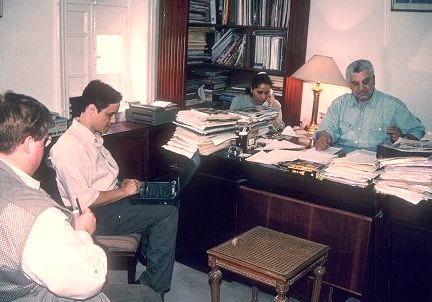
I next met with Dr. Hawass on April 2, 2001 in his office on the Giza Plateau. We opened our discussion with Bahriya:
Guardian: Tell me more about the recent discovery at Bahriya.
Dr. Hawass: I'm writing a story about the tomb of the Governor of Bahriya because this tomb was like a lost tomb that everyone was looking for and we found it.

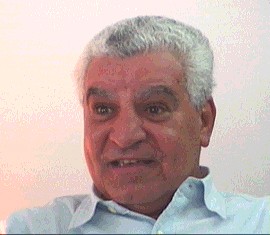
We also found the tomb of his father, Bady Iset.
His father was the first priest of Isis and Osiris. We found beside his sarcophagus 29 beautifully inscribed shawbtis and we also found about a 7 cm gold piece. We found until now 16 people from the family at Bahriya Oasis and we're still looking for 10 more family members. This family is recorded in a temple nearby, the whole family that ruled Bahriya about 500 BC. Until now we've found 6 tombs underneath the houses.This is one of the canopic jars that's
been found near the tomb:
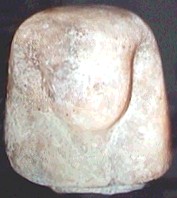
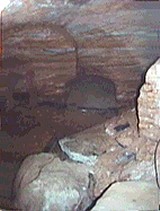 And
this is the tomb of the father of the governor.
And
this is the tomb of the father of the governor.

And also we are excavating at the Valley of the Golden Mummies and we found 11 beautiful tombs with things like this very realistic face.
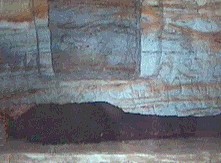 And
this mummy in a tomb.
And
this mummy in a tomb.
Look at this child having tears from his eyes.
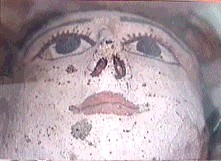
Guardian: Lots of exciting things going on in Bahriya now.
Dr. Hawass: Yes, and I go there every week for three days a week. This is really most important work.
Dr. Hawass: We are also still excavating the tombs of the workmen of the pyramids and we found recently the new tombs that have a shape of a pyramid with a causeway an offering table and we found new titles like "Overseer of the Rollers", "Master of the Harbor" and such titles that tell us about the pyramid builders. This will be included in a story written for the National Geographic, November 1st, 30 pages.
Guardian: On a recent PBS program you mention that the results of the DNA tests conducted by the Cairo Museum on the remains of the pyramid builder indicate that the builders were Egyptian and genetically up and down the Nile, suggesting that they came from both Upper and Lower Egypt. People in the same tombs were related in family groups. Are you planning on publishing this in some journal?
Dr. Hawass: Yes I will publish this in a scientific article and I will send it to you, maybe in two months from now.
Guardian: What was the most surprising finding in the workman's tombs?
Dr. Hawass: The most surprising really that we found inside the Old Kingdom tombs a big, large 26th Dynasty tomb that has a shaft that goes down about 15 feet and we found that it's very large in the north and the south, big. Many tombs have been found, hundreds of tombs now. The new titles that we found are really good. And the more ideas about about the skeletons that tell us about the average height - 5 to 6 feet, the average age of death - 30 to 35. It's still really revealing a lot of information about those ordinary people that built the pyramids.
Dr. Hawass: The
article that I sent you on the site management, this we are doing right now. We made a new opening for the site from the Fayoum Road, and we made an area for picnic for the Egyptians and we are really doing lots of important work for the preservation of the site. By the year 2003 all the camels and horses and the people who sell postcards will be to the south of the plateau. If you go now and see the new project it's incredible. It will be the first model of a preservation of the site that was a mess, and nobody could control, now it will be completely controlled. Now we are starting to build this wall that you cannot see around the plateau that we can really have a full control of the site. And after that we are building to the south the stable, a Visitor's Center under the ground in the desert, and we'll move to Boat Museum out into the desert to be underground. From here, we'll have electrical cars to take the persons to visit and then taking them back.Guardian: Now the electrical cars and the moving of the boat museum, will that also be done by 2003 as well?
Dr. Hawass: No, the Boat Museum is after 2003. But the electrical cars, the Visitor's Center, the parking, the stables for horses and camels and the area for souvenirs, this will be finished by 2003. We'll have a whole tourist facility. The facilities for the tourists will be complete and new, because I don't like to build things here on the site. So, the facilities in the desert will be a complete tourist facility like you'd see anyplace in the world.
Guardian: Did you say there's a model that I can look at or a drawing of this plan?
Dr. Hawass: There is a model yes:
Click to see an enlargement of this model
(this is a big download - 777,391 KB)
Dr. Hawass: The new entrance is finished, this is from the Fayoum Road. It's finished, it's paved, we have a gate for control. After that you go, this is the picnic area we've finished for the Egyptians. The parking area for all the cars will be hidden behind the hill, the stables and for the souvenirs, the parking for the electrical cars that will take you from the Visitor Center under the ground. The electrical cars will take you to and from the pyramids. And that's the Master Plan for the site.
Guardian: The excavations to the south of the Menkaure pyramid, have they been suspended?
Dr. Hawass: We did not do anymore, it's really enough now. We've opened three sites that are supervised, the one in Bahriya which will close at the end of this month, and the workman's tombs and I opened an excavation at Saqqara.
Guardian: I wanted to ask you a few questions about the Bent Pyramid at Dahshur again. What is your own explanation for the two sets of passageways and chambers?
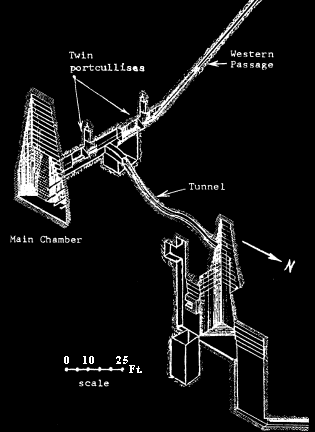 Dr. Hawass:
You know I think that this pyramid, when it was entered by an
architect who worked with Ahmed Fahkry, his name is Abdullah Salem
Hussein, and he did try to examine the whole interior of this pyramid and he
said that this pyramid is like a mystery to him. And he thinks that Sneferu is
buried inside this pyramid and this is why I think there is a reason for Sneferu
to have four pyramids. That maybe he was trying to build that because he
ruled for a long time. Now we believe that he ruled for 54 years. This is more
than anyone previously said. He has 4 pyramids: the Seila Pyramid, the
Meidum pyramid, the Bent Pyramid and the north pyramid. Maybe the idea for
building the North pyramid is to show his power and dignity but he is
actually buried inside the Bent Pyramid. He went back, he started to build
the Meidum Pyramid as a Step pyramid but he left it unfinished. At the end of
his reign he went back and he completed the Meidum pyramid . The Meidum Pyramids
represents the beginning of his reign and the end of his reign. But really
what's interesting is the work that the French did inside that pyramid. They
took one stone from the corridor and they sent the camera and they found a
corridor topped with three chambers and that's really very exciting that we
should really do the same with the Bent Pyramid after we can make access for
people to enter inside then we can really have some major investigations inside
this pyramid.
Dr. Hawass:
You know I think that this pyramid, when it was entered by an
architect who worked with Ahmed Fahkry, his name is Abdullah Salem
Hussein, and he did try to examine the whole interior of this pyramid and he
said that this pyramid is like a mystery to him. And he thinks that Sneferu is
buried inside this pyramid and this is why I think there is a reason for Sneferu
to have four pyramids. That maybe he was trying to build that because he
ruled for a long time. Now we believe that he ruled for 54 years. This is more
than anyone previously said. He has 4 pyramids: the Seila Pyramid, the
Meidum pyramid, the Bent Pyramid and the north pyramid. Maybe the idea for
building the North pyramid is to show his power and dignity but he is
actually buried inside the Bent Pyramid. He went back, he started to build
the Meidum Pyramid as a Step pyramid but he left it unfinished. At the end of
his reign he went back and he completed the Meidum pyramid . The Meidum Pyramids
represents the beginning of his reign and the end of his reign. But really
what's interesting is the work that the French did inside that pyramid. They
took one stone from the corridor and they sent the camera and they found a
corridor topped with three chambers and that's really very exciting that we
should really do the same with the Bent Pyramid after we can make access for
people to enter inside then we can really have some major investigations inside
this pyramid.
Guardian: I noticed you're continuing to do some clearing in there? Is there plans to possibly ease access?
Dr. Hawass: Yes, we have a plan to make the connections with the stairs because you have to jump sometimes and that we are going to do this year. And I will open it to the public but after anyway we investigate this pyramid. I personally believe that Sneferu is buried inside this tomb.
Guardian: Why do you believe that? I've read about others that think that he was buried in the North Pyramid.
Dr. Hawass: Why did he build four pyramids? This is very strange. The Seila pyramid could be like a rest house because it does not have a burial chamber. But why is he not buried at the North Pyramid? Why did he build the North Pyramid?
He could be buried inside this (Bent) pyramid because of one important thing. If this pyramid was left to be neglected he would never do the casing . But the pyramid was cased in white fine limestone and therefore the casing of the pyramid prove that this pyramid was finished for a reason. And this is why he is hiding his burial chamber.
Guardian: What do you think about his wife Hetepheres? People believe that her original tomb was possibly robbed and then moved here to Giza for safekeeping.
Dr. Hawass: No, I believe that this is not true. I believe that Hetepheres was originally buried inside the small pyramid located at the east side of the Great Pyramid, called G1-a. At the first Intermediate Period, in Dynasty 8, there was a destruction of the monuments of Khufu. And therefore some loyal priests withdraw all the artifacts from that tomb and they put it in that shaft.
Guardian: Her body you believe was destroyed?
Dr. Hawass: Her body was maybe stolen at that time. That's why they put it in that shaft and they saved it.
Guardian: If you are to open the Bent Pyramid this would be in a few years?
Dr. Hawass: We have a plan by the architect how we are going to do that. But I need really to do make access for people to enter and after that we do the investigations inside. Then we can know more about this pyramid. And, we'll open Abu Roash to the public. Abu Roash and Abu Sir will be opened together this year.
Guardian: In the Bent Pyramid there's a connecting passageway, up the tall ladder, between the two sets of chambers. Do you believe that it was cut at the time of the building or after?
Dr. Hawass: It was cut at the time of, and if you read what this architect explains, the architect that designed this pyramid intended to do this to deceive robbers. But the burial chamber should be somewhere between these corridors. And the optic camera that the French use maybe can reveal some information for us because that's the only way really to find out.
Guardian: You know when you go to the top of that ladder you can, sometimes not always, you can feel a breeze of air coming through. It starts and it stops. I believe it was Fakhry or Hussein that believed that this indicates the presence of some chamber.
Dr. Hawass: That's Abdullah Hussein, the architect worked with Ahmed Fakhry.
 |
Guardian: In the lower chamber there's a sort of a rectangular opening that goes upward to a shaft, which , part way up opens to a corbelled niche, it's a very unusual feature. Do you have any explanation for this? Dr. Hawass: You have to know that before Giza all really what's happened is just like experiments from the Egyptians. And the final phase for the pyramid is the Red Pyramid, and therefore what's before that it's an experiment from the. We thought that before the five relieving chambers in Khufu were never found in any pyramid. Now you do have relieving chambers at Meidum and therefore we need really more investigation in the pyramid sites to understand are unsolved.
|
Dr. Hawass: That is wrong. I believe all of this is because its the Queen's chamber was left unfinished. It was the chamber that was supposed to be holding the kings mummy, but for architectural reason it was left unfinished. If they didn't finish the north shaft, it was left unfinished after 19 meters. If you go to the south shaft, it's completely finished at 65 meters. And the chamber itself is unfinished, this is why all this are things that happened as a destruction, not as planned to hold the statues or anything. The architect left it unfinished. He left the first burial chamber unfinished 300 feet under the ground. And the reason for that is that I believe that Khufu was the first king who made this religious cult and he appointed himself as a god, the sun god, and therefore he could not be buried like everyone underneath the pyramid. And he left the first burial chamber unfinished after year 5 of his reign, and after that he designed the second room. For architectural reasons they left it unfinished and they designed the third chamber in the middle of the pyramid because he was the sun god himself and he's buried within the pyramid.
Guardian: So the niche on the side of the wall, do you think they would old have closed that eventually?
Dr. Hawass: It was up because the room was never finished . It maybe was intended that maybe a statue of Khufu should be located on the south side of the pyramid because the entrance of the subsidiary pyramid was located between two stones. And I believe that behind these two stones should have something like a statue. And maybe this niche was intended for a statue and maybe it was not, to be hidden and built above it but not be as a shown statue.
Guardian: Last we spoke nobody had come through with a proposal. Since then is there any new proposals for exploring the Queen's chamber shafts with a small robot again?
Dr. Hawass: We are trying to and we hope soon that some people will come but it should come through institutions and things like this.
Guardian: For whatever their various reasons, people are so interested in this.
Dr. Hawass: I'm not in a hurry. It's not Indiana Jones. There are two things that we look to do right by the right people. One is this shaft of the Osiris tomb that I believe that it has become small and narrow and we need an optic camera to see if this goes somewhere or not. And that stop, it's not a door.
Guardian: Are the French still working at Abu Roash?
Dr. Hawass: They are working right now, started today as a matter of fact.
Guardian: I'd like to ask you two questions that they often ask in personal interviews. What do you see as your greatest accomplishment?
Dr. Hawass: The most important thing, the first number one, is the training that I did for the archeo people here at Giza. This has never happened in any place. Those people when I leave my job they can take it over and do better than I do. And that's very important is the continuation of my work. This is my first accomplishment. And the second is the great discoveries that I do. And the third, when I finish this site management, and plan for the conservation of the site it will be the best thing that ever happened. And therefore I think that I will be happy to finish that.
Guardian: Do you have a personal favorite thing that you've discovered of all the many things?
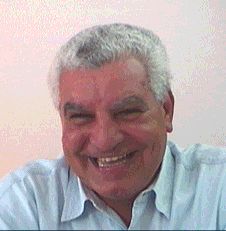 Dr. Hawass:
You know everything for me that I discover is like a baby for
me. And I don't really favor something, but the excavation at Bahriya it
helped the people to understand the archeology more and the public to forget all
this mess about lost civilizations, it's finished now. And I'm glad because I
think the reason for that is that the public never listened to them, so the
subject is closed. And, this archeology thing that we do at Bahriya, these mazes
and corridors, is like an adventure in archeology. An adventure in
archeology makes everyone watch the Fox Special, and National Geographic. National
Geographic is doing a 2-hour special on my work which will be aired on January
1st. That will show to the public that you can dream, but reality is very important,
and the reality is the adventure in archaeology.
Dr. Hawass:
You know everything for me that I discover is like a baby for
me. And I don't really favor something, but the excavation at Bahriya it
helped the people to understand the archeology more and the public to forget all
this mess about lost civilizations, it's finished now. And I'm glad because I
think the reason for that is that the public never listened to them, so the
subject is closed. And, this archeology thing that we do at Bahriya, these mazes
and corridors, is like an adventure in archeology. An adventure in
archeology makes everyone watch the Fox Special, and National Geographic. National
Geographic is doing a 2-hour special on my work which will be aired on January
1st. That will show to the public that you can dream, but reality is very important,
and the reality is the adventure in archaeology.
The Bahriya discovery of the tomb from the 26th Dynasty is amazing. You have underground tunnels, mazes and corridors full of beautiful scenes. Opening the sarcophagi and and finding all this family. We found 6 of them and there are still 10 hidden underneath the houses.
Guardian: I think your website has been very helpful to address the ancient civilization issues because now you have an official outlet that people can easily access from all over the world. And I also enjoy the contrast in the fact that you're using most modern technology, the Internet, to effectively communicate some of the most ancient technology, that of the ancient Egyptians. It's a nice touch.
Dr. Hawass: It is a good balance.
Guardian: Well, I want to thank you.
Dr. Hawass: You're welcome, always.
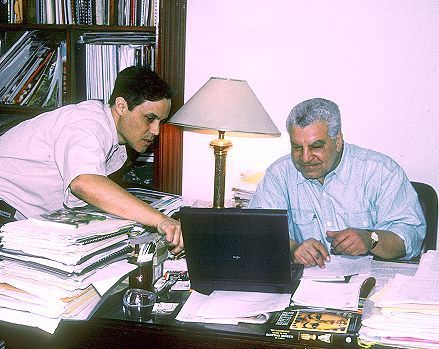
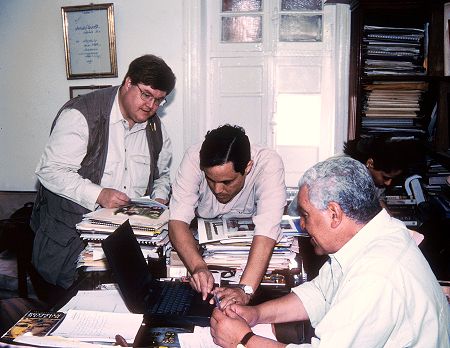

Special thanks to Brent Benjamin, George Johnson and Charlie Rigano
and, of course, to Dr. Hawass and his excellent staff.
|
OTHER SPOTLIGHT INTERVIEWS |
Return to
The Plateau - Official Website of Dr. Zahi Hawass
 RETURN TO
Guardian's Egypt Main Gate
RETURN TO
Guardian's Egypt Main Gate
Return to
Guardian's
CyberJourney To Egypt
Guardian's CyberJourney
To Egypt
Interview and Photos
Copyright © 2001 Andrew Bayuk
All Rights Reserved
4 Photos
(top photo and bottom 3 photos):
Courtesy of George Johnson
Copyright (c) 2001
All Rights Reserved